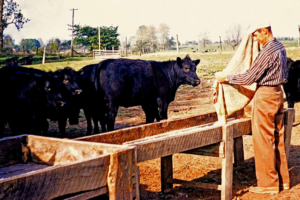Farmer Advisory Groups
 The Southern Ag Exchange Network relies on a variety of professionals and researchers across the region who bring their expertise in sociology, mental health, and other disciplines to the task of addressing farm and ranch stress. But if those experts are the only ones at the table, a crucial voice is missing from the conversation: that of the farmers, ranchers, and agricultural workers.
The Southern Ag Exchange Network relies on a variety of professionals and researchers across the region who bring their expertise in sociology, mental health, and other disciplines to the task of addressing farm and ranch stress. But if those experts are the only ones at the table, a crucial voice is missing from the conversation: that of the farmers, ranchers, and agricultural workers.
Including the perspectives of the farmers themselves and soliciting their feedback is the goal of a pilot program conceived by Dr. Andy Smolski, SAgE’s director of applied research. Starting last December, the inaugural SAgE Farmer Advisory Committee consisted of a small group of farmers in North Carolina.
In return for a commitment of about five hours per three-month period, the members of the committee were offered an honorarium of $500 every quarter, for a total of $1500 over 9 months, which ends next month.
The program’s stated goals were threefold:
- To act as a direct form of representation for the main audience of SAgE
- To support outreach and participation in workshops, trainings, and applied research
- To give input in the application for the next round of Farm and Ranch Stress Assistance Network (FRSAN) funding from USDA-NIFA.
Eight months into the pilot, the project has been successful on the first goal. “Through these dialogues we were provided valuable feedback on the need for a community-grounded approach,” Dr. Smolski says, and based on the group’s responses, adjustments were made to the hotline and pieces of the website.
Feedback about a searchable map feature with the resource database and the importance of that feature being mobile friendly led to a shift in work priorities to focus on those things. “For a small amount of financial outlay, we got a a really grounded understanding of certain project components,” Dr. Smolski says.
While the original goal was to meet monthly, with additional longer meetings every 3 months, the reality of farming made scheduling of these meetings a challenge. Even with a small group of three to five farmers, finding a time when they can all get together for the longer quarterly meetings has been particularly challenging. It quickly became apparent that focusing mainly on the first goal was the most realistic strategy.
From this small beginning, Dr. Smolski and SAgE program coordinator Tesha Humphrey envision building this pilot to a larger group with members across the region. If a group can be established that has 2-3 farmers from each state or territory, it will lead to a greater variety of farm sectors and populations, which was part of Smolski’s original vision—but also, with a group that size, there is less pressure for every farmer to make it to every meeting. Meaningful conversations can happen with even a third of the group.
Moving forward, as the farmer advisory committee evolves to a standing region-wide program, reflection on the pilot project illuminates some areas where adjustments can be made to make it more successful:
- Don’t have the expectation that the initial meetings will accomplish work—some time needs to be allowed for the group to get to know each other.
- In addition to the meetings, a member of the SAgE team should regularly check in with the farmers to ask for feedback, but also to establish a rapport with them.
- Narrow the focus of the group to the feedback and representation piece, and if the other pieces of the stated goals happen organically, consider that a bonus.
If you are a farmer who is interested in participating in the farmer advisory group, or if you know someone who might be interested, please contact Tesha Humphrey.
